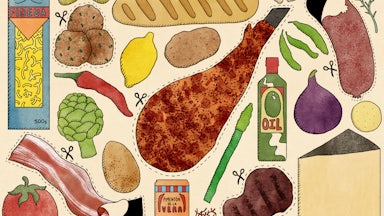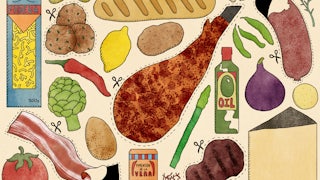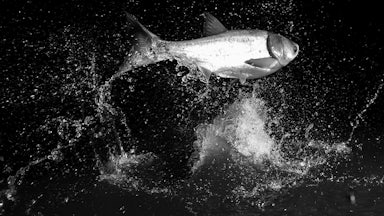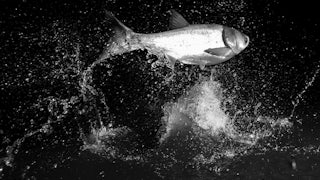The protests were clunky, juvenile, and designed to outrage: On October 15, activists with the animal rights group Animal Rebellion marched into supermarkets in cities across the United Kingdom, including Whole Foods, as well as posh Harrods. They brandished banners that read “Plant Based Future” and began opening and spilling bottles of milk on the ground and onto display cases selling fresh meat. Coming just a day after climate activists with Just Stop Oil splashed tomato soup onto the glass covering a Van Gogh painting at London’s National Gallery, the demonstration provoked widespread public condemnation and very little sympathy.
Centrists, conservatives, and many leftists have long called animal rights activists privileged and out of touch. And admittedly, with a cost of living crisis and increasing food insecurity sweeping the U.K., the packs of mostly white young people wasting perfectly good milk didn’t do much to dispel this image. The inconvenient truth, however, is that the Animal Rebellion protesters are right.
The food system, Animal Rebellion argues, is unsustainable and irrational: “Given a blank piece of paper, not a single politician, policy maker, or farmer, would today design a food system based on animal products.” The science agrees with them: It is becoming increasingly clear that we need to shift our food production systems and diets away from animal agriculture to keep food production within planetary limits and limit its contribution to climate change, biodiversity loss, and the risk of future zoonotic disease outbreaks. That means reducing animal agriculture.
But people aren’t listening. While the number of vegans in countries like the USA, Germany, and the U.K. is slowly inching upward, and plant-based meat and dairy alternatives are becoming ever more ubiquitous, these are outstripped by growing global meat and dairy production and demand. Global agricultural animal production is projected to rise by about 75 percent by 2050. That means that one of the primary drivers of deforestation, the biodiversity crisis, and burgeoning food emissions is growing at an astonishing rate but is only facing a fraction of the opposition that is currently devoted to fossil fuels—despite the fact that meat can be reduced or cut out of daily life more easily and quickly than fossil fuels can be.
Rather than taking these facts seriously, most people—even those who care about climate issues—are happy to mock or dismiss vegans. The question of dietary change, be it veganism or meat reduction, strikes at the heart of the imaginative difficulty people have with any politics aimed at building a sustainable future: It is necessary but impossible—which is to say, it’s theoretically more feasible than many other climate actions but practically unviable because of tremendous cultural resistance.
In the U.K., where Animal Rebellion is based, the meat and dairy industries are the country’s primary source of waterway pollution, leaving rivers choked with algal blooms and dead fish. Despite warnings going back almost a century, such waste has increased with little mitigation. In his recent book Regenesis, a lamentation of where agriculture has gone wrong, journalist George Monbiot sees the story of ruined rivers as one of a British countryside in thrall to farming interests and a declawed regulatory state that fails to enforce basic regulations against polluting dairy and chicken megafarms. On the few occasions when farms are investigated and fined, those fines amount to a slap on the wrist and don’t necessarily address the underlying problems. Meanwhile, these megafarms are proliferating, with well over a thousand concentrated animal feeding operations, or CAFOs—defined as housing over 125,000 chickens or 700 dairy cows—now churning out meat, eggs, and dairy and despoiling the British countryside. That massive scale of production also leads to a massive scale of waste. Those criticizing Animal Rebellion for wasting a few pint bottles during their protest might not know that 490 million pints of year are wasted every year in the U.K. by consumers alone, part of the 330,000 metric tons of milk wasted overall across the country. Globally, one out of every six pints of milk produced is wasted, or 116 millions tons. And that’s besides the net protein and calorie loss of growing feed crops to then feed to animals: The protein conversion efficiency—meaning the amount of protein inputs in fodder that are converted into animal protein for human consumption—of dairy milk is a measly 14 percent and of beef an anemic 4 percent.
Stateside, in the birthplace of the CAFO and the industrial feedlot, the situation is likewise dire. The reservoirs of the once-mighty Colorado River, which helps irrigate the vast majority of agriculture in the western United States and provides water to tens of millions of Americans, are down to historical lows. The main culprit here is not just drought or demand for drinking water but feed crops for beef and cattle like alfalfa, which itself is responsible for 37 percent of all water drawn from the Colorado. California’s 1.7 million cows not only require 142 million gallons of water per day, but their manure contributes to the dangerously high nitrate levels in groundwater (almonds, in fairness, aren’t doing California’s water table any favors either). Waste is also rampant, often due to the vagaries of the market for milk, which is highly perishable. In the first eight months of 2016, facing low prices and an oversupply of dairy, farmers dumped 43 million gallons of milk. In early 2020, with Covid-19 reducing demand, American farmers were dumping 3.7 million gallons of milk every day. Overall, between 30 and 40 percent of all food produced in the U.S. is wasted. That number takes on a grim viscerality when translated into animal lives. Over a billion chickens, as well as about a 100 million other animals, are slaughtered every year only to be tossed into landfills.
If we’re serious about rationally managing resources and building a more sustainable food system, then surely such a brutal, inefficient, polluting industry should by all rights be first on the chopping block. And that’s before you get to the animal welfare and animal rights arguments.
Here is where we arrive at the great paradox of opposition to dietary change. Surveys repeatedly show that a significant number of Brits and Americans support bans or at least moratoria on factory farms. But these attitudes aren’t reflected in shopping decisions, with the average American wolfing down about 250 pounds of meat and 655 pounds of dairy.
If we did eliminate factory farms, that would mean eliminating about 70 percent of all cows and 98 percent of all chickens and pigs. That would make the U.S. de facto mostly vegan overnight, and even if smaller and higher-welfare farms scaled up, they couldn’t come anywhere close to the output of CAFOs or match factory-farmed meat, dairy, and eggs on price.
But would the public accept this? Likely not. In fact, despite the claims of critics that meat reduction is a less polarizing and more nuanced set of discourses and policy approaches than veganism, there is little proof that this is the case. For instance, when the EAT-Lancet commission, a collaboration of the food nongovernmental organization EAT and the vaunted British medical journal The Lancet, released its proposed diet for maximizing human and planetary health in 2019, it was met with scathing critique from all corners of the political spectrum, including a massive online countermovement under the hashtag #Yes2Meat. This despite its optimal diet allowing for more meat per day per capita than would be available to Americans if they shuttered their factory farms. Last July, Spain’s minister of consumer affairs, Alberto Garzón, was widely pilloried simply for daring suggest that Spaniards should voluntarily eat slightly less meat.
The primary culprit here is taste. The vast majority of Americans, regardless of gender or creed, choose food based on taste, followed by nutrition, followed by affordability, with environmental and social concerns falling far behind. So given that consumers are acculturated to liking meat and dairy, and are used to having ubiquitous and affordable meat and dairy options where they get food, meat reduction is a very hard sell.
The other problem is that consumers and citizens alike are reticent to make sacrifices for the sake of the planet, especially given the perceived ineffectuality of individual changes in the face of large-scale political and ecological problems. And asking people to give things up is generally poor electoral strategy. Centrists, who often conflate electoral and consumer choices, have critiqued policies aimed at reducing meat consumption as illiberal and undemocratic. This despite the fact that democracies regularly ban harmful things.
This may explain why environmentally conscious progressives have gotten behind initiatives like the Green New Deal and the broader theory of supply-side progressivism that are predicated on giving people more stuff—jobs, amenities, goods, services—rather than less but doing so in a more environmentally sustainable manner. When the left-wing environmental scholars Troy Vettese and Drew Pendergrass recently suggested that “widespread veganism” would be desirable in a political economy designed not to overshoot planetary limits in their book Half-Earth Socialism, they were strafed by friendly fire. Despite the fact that meat reduction, for all the reasons described here, was objectively the most scientifically sound and least extreme position in the book, it was soon deemed “the most preposterous proposal of all” in a review, and panned by a podcaster who proudly proclaimed himself a fan of “both sausage and socialism.”
The problem seems intractable. Few people’s utopia involves wearing a hair shirt and giving up culinary pleasures; utopia and sacrifice are, for many, antonyms. Yet it’s hard to imagine a utopian society that allows factory farming and river-destroying megadairies.
Bizarrely, the only group in the U.S. that takes widespread veganism seriously is the right, which has started fearmongering about democrats taking away America’s hamburgers and decrying “fake meat.” But its interest in veganism is solely as a potential culture-war dog whistle.
So what is to be done? There is a host of policies that could be embraced to gradually reduce animal product consumption or support the development of alternative proteins that would meet consumers as close as possible to where they are on taste, habit, and cost. Climate change might force our hand as well. But perhaps the first step is actually taking the catastrophe of animal agriculture seriously. And that means treating veganism not as a punch line but as the basis for real policy and necessary social change.
That might take some introspection. There is a snarky, self-assured, and defensive contrarianism to the knee-jerk anti-vegan position that’s every bit as juvenile as spilling milk on a supermarket floor. We can’t start having serious conversations about ecologically necessary changes to agriculture and the food system—whether these take us to small farms or cell-based proteins—until we’re willing to consider taking meat, eggs, and dairy off the menu. And that means recognizing that the Animal Rebellion kids—and, yes, the rest of those pesky vegans—are far more right than most would want to acknowledge.










